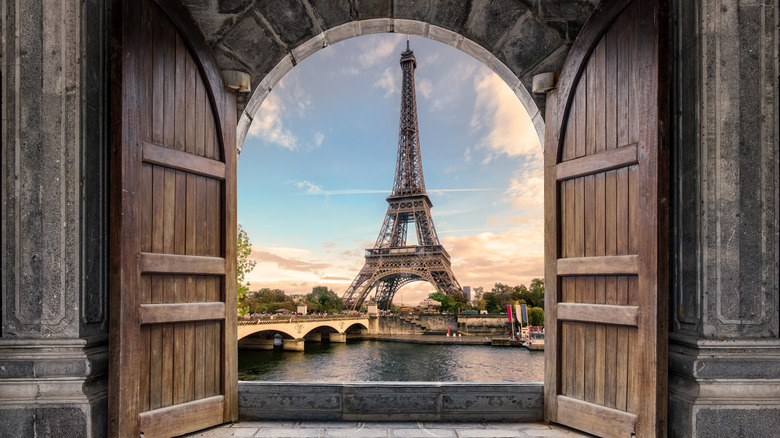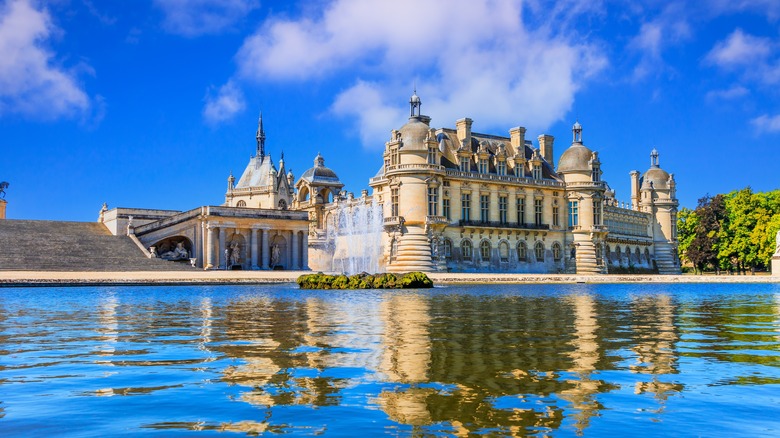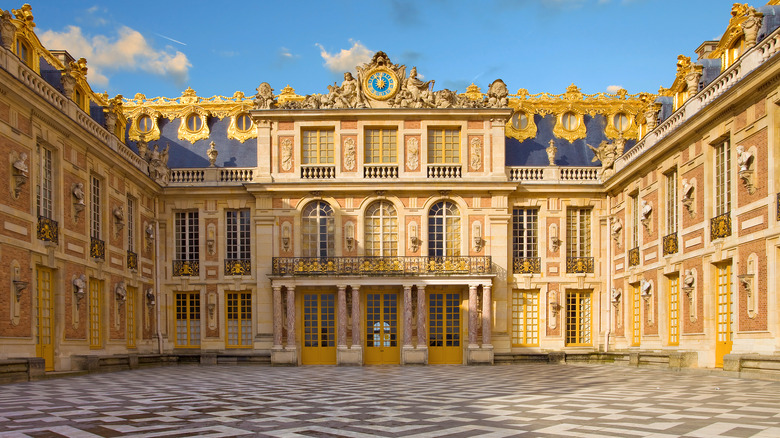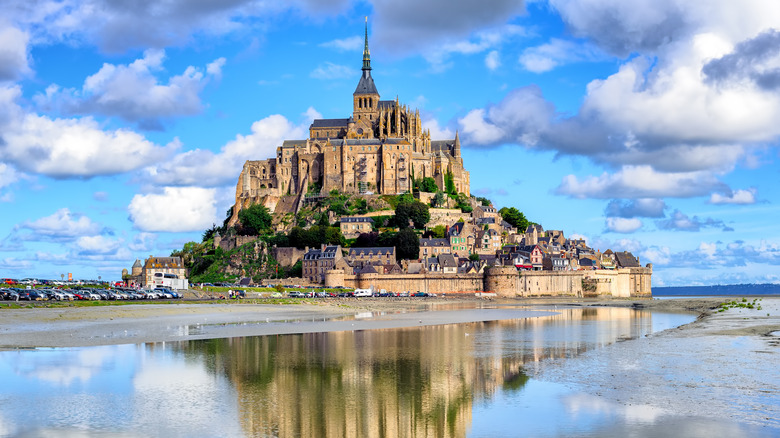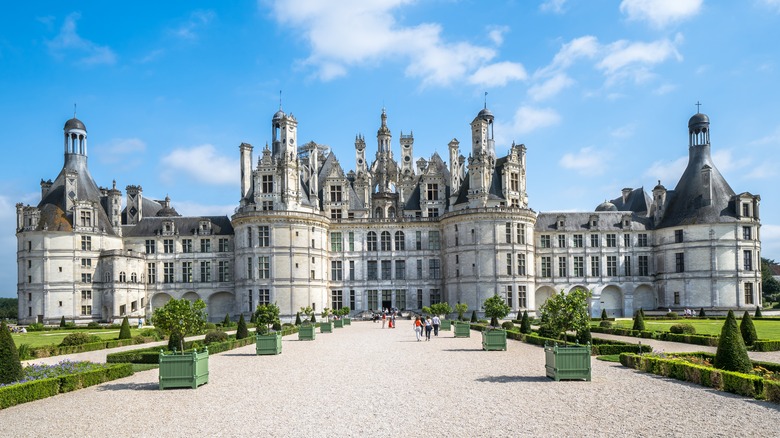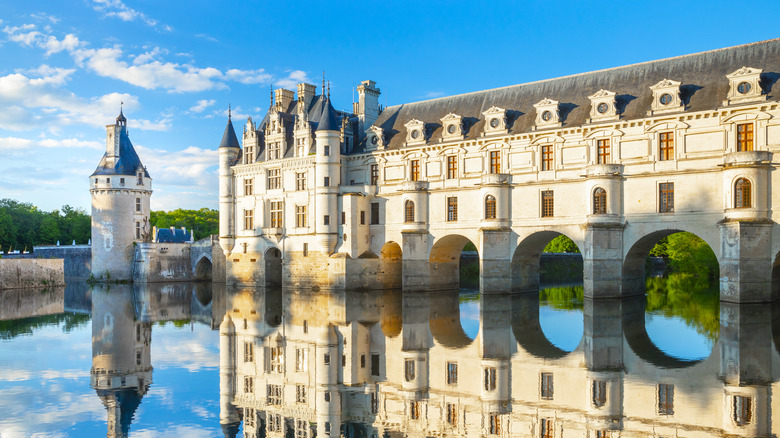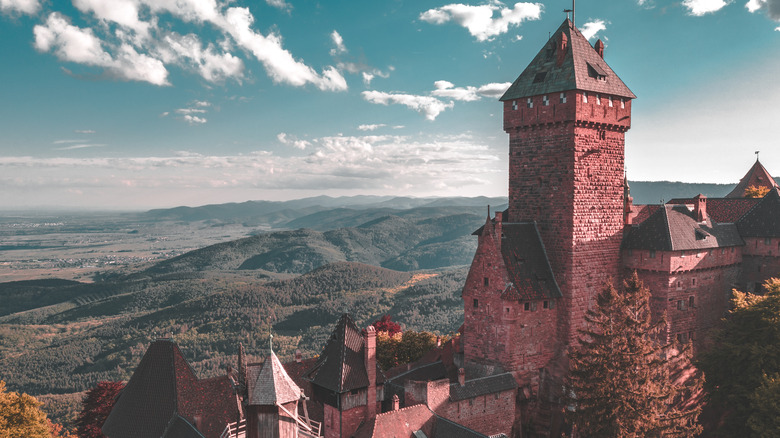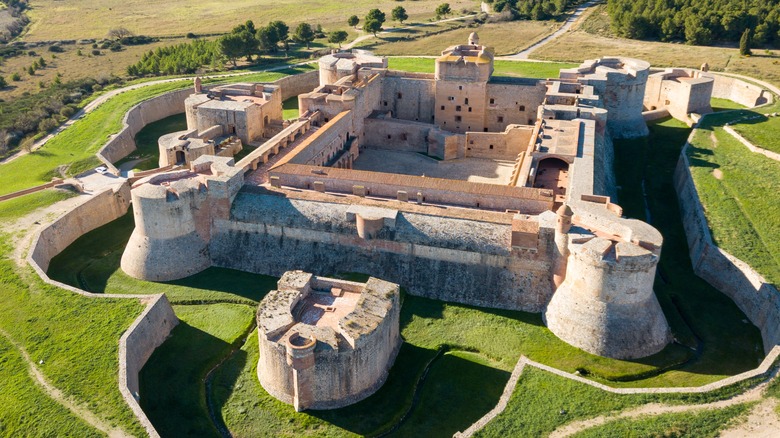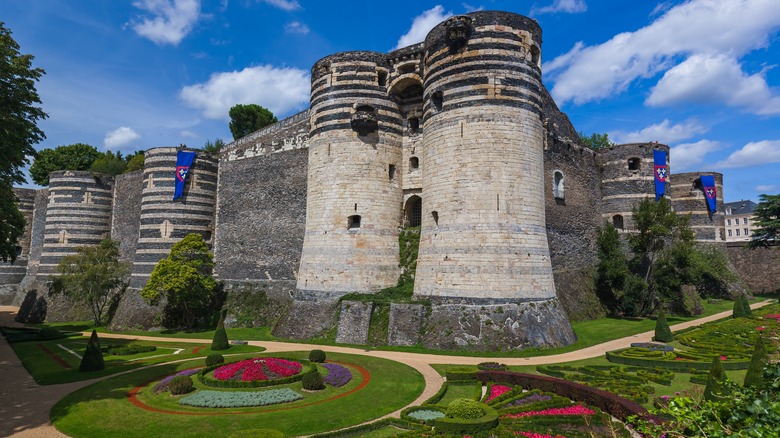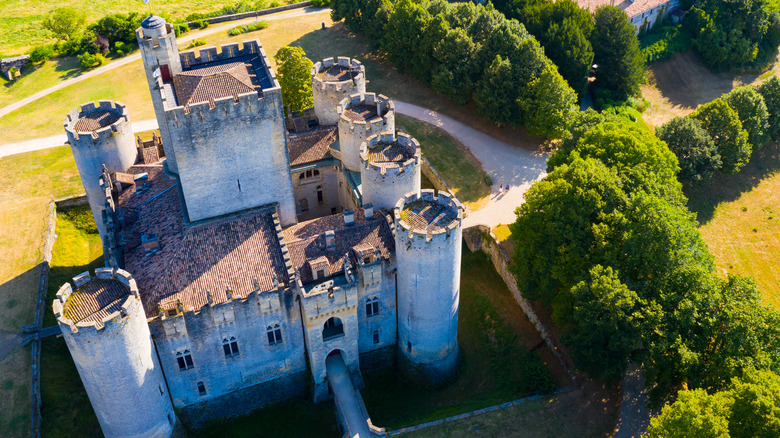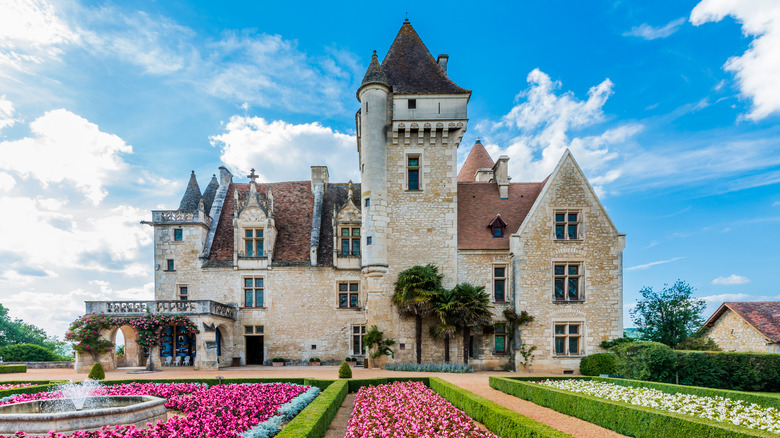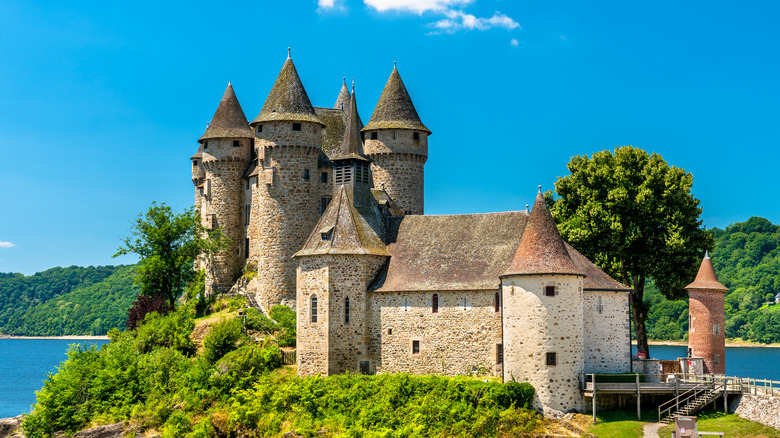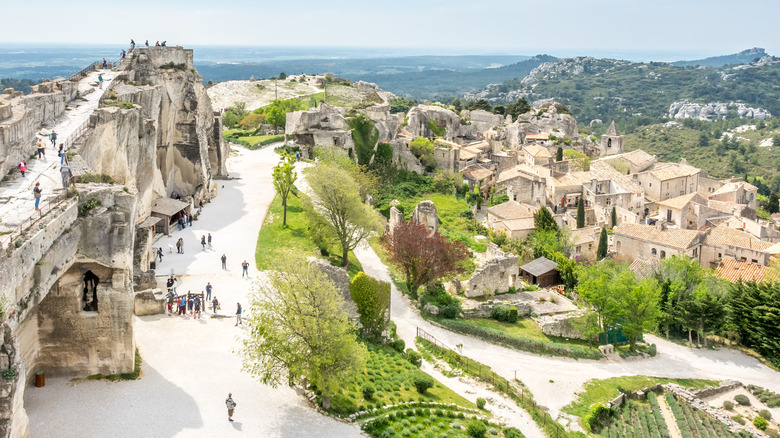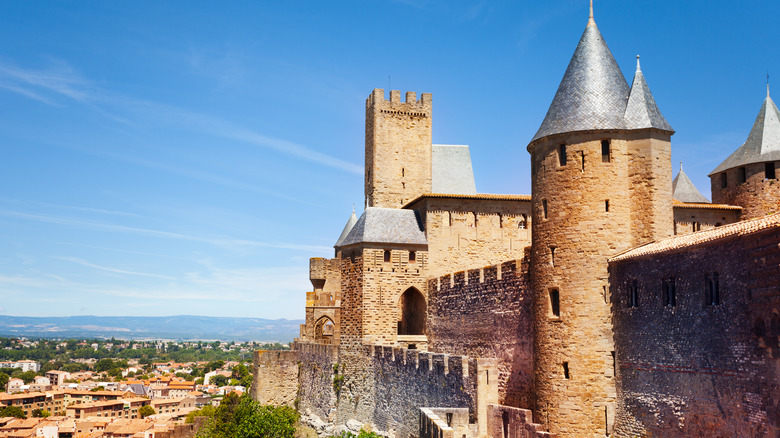Must-See Castles To Visit On Your Next Trip To France
France is one of the most stunning countries in Europe, with no shortage of champagne, croissants, or castles. Of course, people come from far and wide to visit one of France's most iconic cities, Paris. But after a comprehensive tour of the Louvre, dining in a wealth of amazingly good cafés, a few pictures of the Eiffel Tower, and a day trip or two to popular nearby places, you'll likely want to delve a little deeper into all the wonderful things that France has to offer.
Whether you are a history lover, a palace enthusiast, or just there for the view, french pastries, and a generous pour of champagne, you definitely won't be disappointed with all that awaits you in France. In fact, this gorgeous country has over 40,000 castles (bastions, fortresses, and citadels) to peruse (per Le Long Weekend). So curious visitors ready to explore the rest of France and marvel at some of the most majestic French châteaus around can start with these intricate and lavish structures the next time they're in town.
Château de Chantilly is close to Paris
For travelers who happen to be vacationing in Paris, a day trip to the magnificent Château de Chantilly is definitely in order. Located in the Picardie region of France, this castle is just simply stunning. Though no royals ever called the original palace home, Château de Chantilly was built in the early 1500s by a prominent French family, the Montmorency (via Freedom Tour Travel). During the mid-17th century, this little castle (as it was often referred to) was transferred via marriage to the Orléans family.
Around the time of the French Revolution, the original Château de Chantilly was almost destroyed entirely. However, the Orléans repaired many of the remaining structures after the French Revolution. It was not until the late 1800s that Château de Chantilly was completely rebuilt into what it is today. With a rich history, a fairy tale-like presence, and even a moat, this palace is truly impressive and worth a visit. Château de Chantilly is also a great place to start if you are not one for massive crowds, but still love a fascinating abode that is far from little (per Chateau de Chantilly).
The Palace of Versailles is one of the most famous castles in the world
Of course, no castle quest is complete without the Palace of Versailles. In 1624, the former lodge and hunting grounds for Louis XIII began its transformation with a small addition: a modest château. When Louis XIV came into power, the once modest château was very much upscaled into, well, a palace fit for a king. The elegant touches and royal add-ons continued through Louis XV and Louis XVI's reigns (per Talk Travel App).
With extravagance being the name of the game, the Palace of Versailles became what it is today — practically one of the world's wonders. Moreover, this royal residence, with its extensive and lush grounds, definitely stood the test of time (thanks to ongoing upkeep and maintenance). Now, one of the world's largest and most famous castles, the Palace of Versailles is brimming with over five centuries of history, priceless artwork, innovative architecture, and more. So, do yourself a favor and carve out extra time to fully take in this enchanting place and its picturesque grounds — just be careful, as you may never want to leave (per Chateau Versailles).
Mont Saint Michel is taking Instagram by storm
Yet another well-known royal gem that is only a nice day trip away from the City of Love is Mont Saint Michel. This castle, perched on its very own island, was once nothing more than a dream. According to local legend, in the 8th century, bishop Aubert was visited by the Archangel Michael in a dream, where Aubert was given clear instructions and blueprints (via Normandy Tourism).
Mont Saint Michel, over the millennia, has been many things besides just impregnable — a dream castle, part train station, part chapel, an abbey, a bustling business district, and even a prison. This picture-perfect abode even has a British twin called Saint Michael's Mount in Cornwall (per My French Country Home Magazine). But what's most interesting about this French palace is that it continues to symbolize France's ancient social hierarchy. Almost bewitching when you finally lay your eyes on it, Mont Saint Michel is truly a sight to behold and makes the phrase "a picture is worth a thousand words" take on a whole new meaning.
Château de Chambord is the largest castle in France
After seeing the country's most famous and photogenic castles, travelers can take things a little further by visiting Château de Chambord, France's largest castle. Built between 1519 and 1547, this gorgeous abode is fit for royalty, and is a true ode to 16th-century French Renaissance architecture (per Chambord). Commissioned by Francis I as a larger-than-life hunting lodge, this castle is much more than a place to kick back and relax after a good royal hunt.
Château de Chambord has a medieval castle look and feel, despite not being built with military defense in mind. Here, the influence of Leonardo da Vinci is also apparent throughout. And with enough space to accommodate well over 300 members of the king's court, it is not too surprising that this castle takes up some serious acreage (via Hotels). In fact, there are 426 rooms, 282 fireplaces, 83 staircases (including the famous double helix staircase), and lush grounds with a private park that is said to be as large as inner Paris. So, when visiting this incredible palace, don't forget to wear some comfortable walking shoes.
Chenonceau Castle was the home of a mistress of Henry II
Chenonceau Castle is a unique-looking palace with a rich history dating back to the early 1500s. However, writings that mention the estate of Chenonceau go as far back as the 11th century (per Chenonceau). Built on the foundation of an old mill, the castle was a labor of love by several French Renaissance architects at the time. What makes this château so special is its attention-catching bridge and an almost perfect blend of early Renaissance and late Gothic designs.
Diane de Poitiers, the mistress of Henry II, was gifted Chenonceau Castle after the estate was burned down, rebuilt, and then repossessed by the crown. Diane oversaw the bridge's building, and added her personal touches to the home and surrounding grounds. Overall, this one-of-a-kind former home of Henry II's mistress has a design that is like something out of a fairy tale. Spanning the entire width of the River Cher, Chenonceau Castle is worth a visit, and is France's second most popular stately home after the Palace of Versailles (via Trip Anthropologist).
Château du Haut-Kœnigsbourg was abandoned in the 1600s
Often, there is an inherent beauty in things that people and time have abandoned, and such is the case with Château du Haut-Kœnigsbourg (per Haut-Koenigsbourg). Constructed in the 12th century, this particular medieval castle had a front-row seat to the ongoing turmoil between rulers that was somewhat commonplace in Europe from the 12th to the 17th century. Still, by 1633, this fortress sat defeated.
Left in ruin for over 200 years, it was not until the 1900s that Château du Haut-Kœnigsbourg underwent a full castle restoration (via Visit Alsace). By then, the palace was classified as a historical site. But, in less than nine years, this castle was completely rebuilt. In 1908, the alluring Château du Haut-Kœnigsbourg was officially finished, and has been open to the public ever since. Filled with centuries of history, revolutionary architecture, paintings, medieval furnishings, and more, Château du Haut-Kœnigsbourg is one of the most visited castles in France.
Fort de Salses looks like something out of Game of Thrones
In many ways, Fort de Salses is the true definition of a 15th-century military fortress or compound (per Forteresse Salses). Built by the Catalans in 1497, this grand defensive structure was constructed on the ruins of a former castle (destroyed by the French army forces only a year prior). Here, the goal with Fort de Salses was to essentially provide an added layer of protection near the border and along a crucial transportation route.
Though still considered a palace or castle, even back then, Fort de Salses's overall military or defense capabilities were unmistakable. With such a meticulous structural design, defensive architecture, ten-meter-thick walls, a drawbridge, a moat, and more, it is hard to ignore the serious Game of Thrones vibes here. Over 100,000 people visit Fort de Salses annually to marvel at this extraordinary engineering feat (via Travelin Pink). So, this is clearly another must-see castle in France that you should check out when you get the chance.
Château d'Angers has alluring gardens and more
Yet another French masterpiece waiting to be discovered is Château d'Angers. Picturesque inside and out, this medieval castle has roots dating back to the 9th century. Interestingly, this humble abode's official construction date is actually closer to the 13th century (per Chateau d'Angers). Since then, Château d'Angers has seen its share of restoration projects and repurposing (particularly between the 15th and 17th centuries). This is impressive, given that this estate fit for a king or queen is made partially of timber. What's more, some of the most picturesque grounds and lush gardens surround this rather inviting home, including the breathtaking curated moat garden and the main garden, which are absolute must-sees.
After stopping to smell the roses and snapping a few Instagram-worthy photos of the gardens, visitors should also make it a point to check out the other main attractions at Château d'Angers, like the Apocalypse Tapestry. Not only is this tapestry the oldest and largest in the world, but it is also downright interesting (via France This Way). The medieval tapestry depicts the story of the Apocalypse from the Book of Revelation by Saint John, and is reason enough to stop by Château d'Angers.
Roquetaillade is a storybook castle brought to life
Located in Bordeaux, Roquetaillade is definitely one for history lovers and the storybooks (per Bordeaux Tourism). This French fortress is an incredible work of art that was built on the ruins of a pre-historic castle by the legendary Charlemagne. Not long after, King Edward I of England created another fortress in its place around 1306, which includes many of the structures that make up today's Roquetaillade (though some restoration was done during the early 19th century).
Perched on a limestone plateau, this medieval bastion has all the makings of a once-upon-a-time castle, including several towers, a dungeon, and reinforced ramparts (via Cultured Kiwi). Owned by the same family for over the last 700 years, Roquetaillade has been quite the fortress (this estate is actually two fortresses joined together). With a 19th-century lavish interior, a dash of defensive prowess, and an abundant history, Roquetaillade is on the list of the best castles in France to visit.
Château des Milandes is what happens when gothic style meets jazz
This gothic-style dream come true has it all and then some: incredible design, attractive gardens, roots dating back to 1489, and even a touch of Jazz, thanks to Josephine Baker. That's right — this impressive structure once belonged to this famous 1920s Jazz performer, who was one of the first internationally recognized African American entertainers and a true legend ahead of her time. Her style and presence are still very much a part of this gothic-style palace. In fact, it is because of Baker that Château des Milandes has worldwide recognition (per Milandes).
Before Baker acquired this stunning residence, Château des Milandes belonged to the Caumont family. This palace stayed in their possession until the French Revolution. However, it was abandoned shortly thereafter. Eventually, this magnificent castle, which was almost in ruins at this point, exchanged hands a few more times in the 19th century. It wasn't until 1914 that Château des Milandes underwent a full restoration thanks to an industrialist named Charles Clavier.
Clavier also added a contemporary-style winery and a farm to the property. Baker subsequently purchased the home and made it her personal sanctuary until being forced to sell in 1968. However, in 2001, the castle was bought by a mother-daughter duo, Claude de Labarre and her daughter Angélique de Saint-Exupéry. They turned it into the museum dedicated to Baker that you can visit and enjoy today (via Maryanne's France).
Château de Val has a haunted appeal
In the quaint village of Lanobre, on a tiny peninsula in the waters of the Bort-les-Orgues Reservo, Château de Val sits. Dating back to the 13th century, this abode has been abandoned and restored several times throughout history (per France This Way). Many believe it is because of this that Château de Val is likely haunted. Whether the rumors and scary stories are true is definitely up for debate. But, seriously, who doesn't love a good ghost story, especially one set in a larger-than-life castle?
Even if a visit to Château de Val doesn't give you the chills, it will definitely leave you nothing short of awestruck (per Castles). Thanks to its location, this castle stands out along the Bort-les-Orgues Reservo, and every now and then, the visitor parking area becomes engulfed by its waters. When this happens, Château de Val looks surrounded by a moat, which takes its medieval factor up a notch. Overall, this local attraction's interior and exterior have been restored to their former glory — and it is simply beautiful.
Château des Baux de Provence is more than just ruins
Though this French masterpiece is still lying in ruin, unlike many of the other castles, it is still worth experiencing in person. Château des Baux de Provence is an important part of France's history and feels like something that is beyond ancient (via Chateau Baux Provence). In addition to taking in all that remains of Château des Baux de Provence, visitors can check out several exhibits and medieval weaponry demonstrations that regularly take place at this once commanding fortress.
Château des Baux de Provence was built in the 10th century in one of the most beautiful towns in France. Located at the highest hilltop in the village, visitors can only imagine how intimidating this fortress was (per Avignon Et Provence). Though no one may ever know what Château des Baux de Provence really looked like, this castle from the Middle Ages has completely unobstructed and downright enchanting views of the Alpilles, making it another must-see on your castle quest.
Château Comtal de Carcassonne is pure inspiration
Last but not least, located in the historic town of Carcassonne, Château Comtal awaits castle enthusiasts. This beautiful 12th-century palace with a world-famous museum is rumored to have inspired the likes of Disney, in addition to being the setting for Kate Mosse's "Labyrinth" (per Laramoneta). So if you are in the process of creating your next book, television series, or film, then a trip to Château Comtal de Carcassonne should absolutely be on the itinerary.
Of course, visitors can still marvel at Château Comtal de Carcassonne without being in the midst of a creative project. With incredible works of art, medieval artifacts, rich history, and the almost two-mile-long ramparts that you can walk, a day at Château Comtal de Carcassonne is a day well spent. Plus, this breathtaking medieval fortress is surrounded by the fully intact ancient city walls of Carcassonne, which is something you don't see every day (via Cathar Castles).
